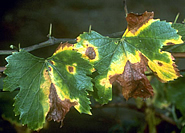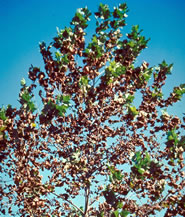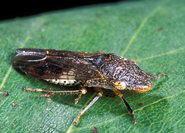This page has been archived and is being provided for reference purposes only. The page is no longer being updated, and therefore, links on the page may be invalid.
|
|
Threat to Grapevines and Gardens Now Easier to Pinpoint
By Erin PeabodyJune 19, 2007
It used to be that tracking the bacterium Xylella fastidiosa—one of the most serious threats to the California wine industry—was as challenging as teasing out the fine, commingling aromas of a complex Bordeaux.
Now, scientists with the Agricultural Research Service (ARS) in Beltsville, Md., have developed a method for quickly confirming whether an insect or plant harbors the destructive, disease-causing bacterium.
X. fastidiosa is best known for causing Pierce's disease in grapes, having ravaged California vineyards throughout the 1990s. But this menacing microbe, transmitted by various piercing insects, also attacks almonds, peaches and plums, as well as landscape trees as economically important as elms, oaks and sycamores.
Qi Huang, a plant pathologist in the ARS Floral and Nursery Plants Research Unit, a part of the U.S. National Arboretum operated by ARS in Washington, D.C., developed the new method for quickly finding out if an insect carries X. fastidiosa. She's reduced the sticky business of extracting and analyzing bacterial DNA from inside an insect to two simple steps, which can be completed in under a day.
Little is generally known about the particular X. fastidiosa strains impacting landscape trees and how they differ from strains plaguing vineyards and other crops. Especially vexing is not knowing whether the isolates responsible for causing Pierce's disease in grapes can affect landscape plants—and vice versa.
The new method should help fill in such gaps in knowledge about transmission of different isolates of the Xylella bacterium.
Huang's test relies on two parts: a commercially available DNA-extraction kit and a DNA-amplification protocol that uses primers—short pieces of DNA specific to the bacterium's genetic code—to serve as proof of its presence.
The new method is more powerful than the current Xylella-detecting standby, which uses technology known as ELISA, for "enzyme-linked immunosorbent assay." ELISA can't recognize low levels of the bacterium, which has likely left many potential Xylella-transmitting insects to go undetected.
ARS is the U.S. Department of Agriculture's chief scientific research agency.



